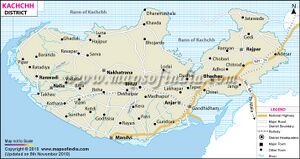Khirasara
| Author:Laxman Burdak, IFS (Retd.) |

Khirasara (Khirsara) is an archaeological site belonging to the Indus Valley Civilization in Nakhatrana Taluka of Kutch District in Gujarat.
Location
This site is located in Nakhatrana Taluka of Kutch District in the western Indian state of Gujarat. The Nakhatrana is 386 km away from Ahmedabad. Chirai River originates at Khirsara, Modsar village, Ta: Anjar (Kachchh) & meets in Bay of Kuchchh
Site of Indus Valley Civilization
Excavations: During 1976-77 exploration, an Archaeological Survey of India official discovered a big cubical weight, chunks of pottery, sprinklers and spouts of red polished ware from the site.[1]
In December 2009, a team from the Vadodara division of the Archaeological Survey of India started excavation at this site after the discovery of a 300 m² fortification wall.
Specimens of fine perforated pottery were discovered from the site during the excavation.[2] Seals found at this site are exhibited at Bhuj Museum. Discovery of a "warehouse" was a big achievement. Houses have been found signifying beautiful residence of the community. Rectangular shaped rooms, connected to each other and furnace for cooking; and foundation pillars have also been found. The walls of the houses are made with bricks and mud. For making footpath outside the houses mud, pieces of vessels, shells and small stones have been used.
Bone pots (used to preserve ash and bones after death) and pieces of shells have been recovered from the rooms. Unearthed some fine specimens of perforated pottery, which will be matched with the items recovered from other Harappan sites in order to identify and date them. The ones found in the upper layer are likely to belong to a later period while the ones found in the deeper layer will be older. The "subsistence pattern", or the trade and livelihood options of the lost colony will also become known after further excavations.
The Archaeological Survey of India has recovered a survey instrument, comparable to modern prismatic compass, from the site called Gadh-vali vadi.[3]
External links
References
Back to Indus Valley Civilisation

